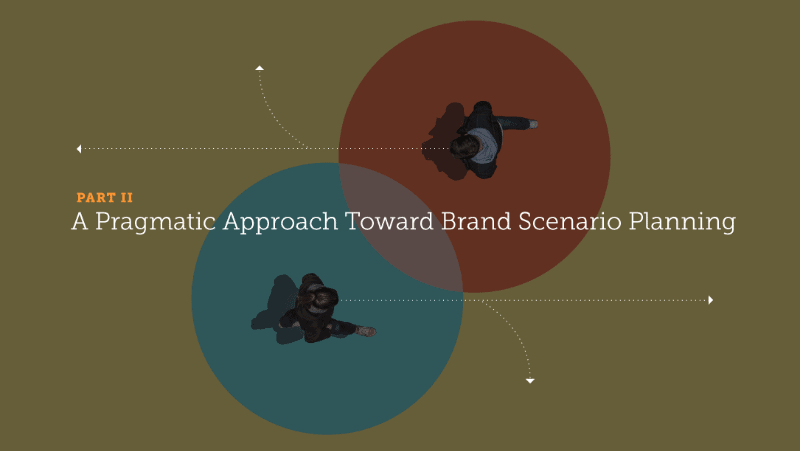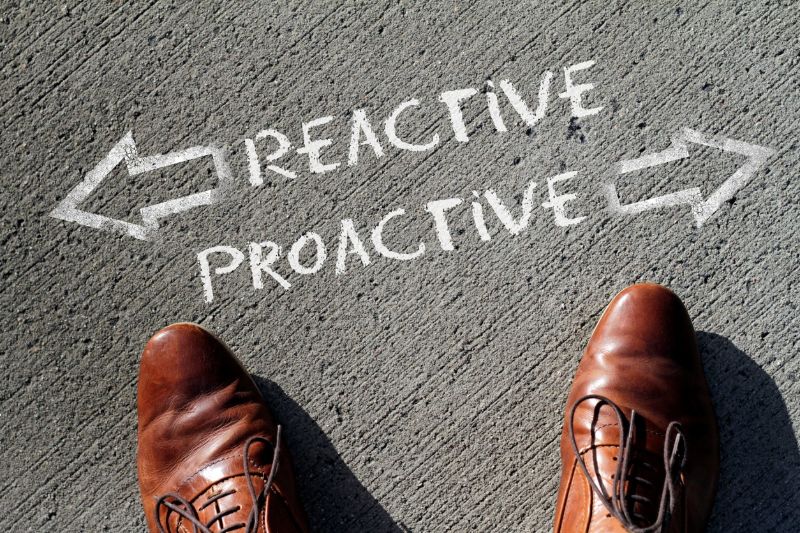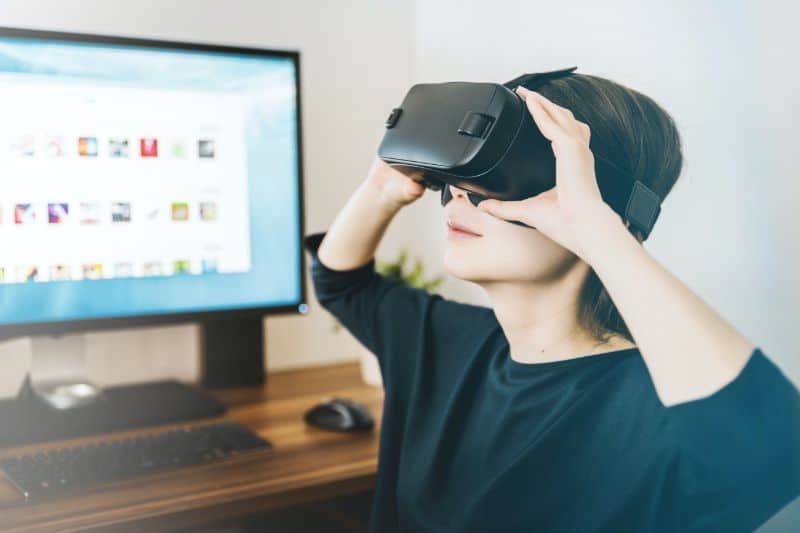A Pragmatic Approach to Brand Scenario Planning: Part II

If you haven’t read Part 1 about Brand Scenario Planning yet, please start here.
| Part 1: (read here) | Part 2: |
|---|---|
|
|
How might we respond?
Now that we have begun to paint a picture of what tomorrow might look like, we can now turn our attention to what we might do and how we might prepare for that day. The first of these, is the position we take on the future, or how we believe the future will unfold based on the figurative “bets” we make, as discussed earlier. When we identify the uber themes that will most predominantly affect our industry and business, and combine them with anchor scenarios, we assemble a position on the future that can orient leaders of the organization around a common stance. This position will also help to guide brand thinking around a future proposition and imperatives. Following is an example of a narrative from a healthcare client that brings to life how a company’s position, or belief system might be expressed.
A U-shaped, rollercoaster recovery with significant change for a minority of segments
We are optimistic that a full recovery will come but believe that it could take up to 5 years, as predicted by experts. We will see both decline and growth in different pockets of the economy which will result in an uneven, roller-coaster recovery for the foreseeable future. While large segments of our population will make it through with minor disruptions, others most affected will experience severe change and hardship.
Three factors that will shape our future above all others:
1. Extreme dislocation and imbalance in our supply-and-demand economy
The dislocation of large segments of our population and imbalance in our economy will widen inequality. This will leave large groups with an inability to pay for their healthcare, and thus increase dependence on the federal government. It will also result in significant shortages of qualified workers in industries like ours.
2. Deep-felt and long-lasting trauma of populations whose lives will never be the same
The emotional trauma inflicted by the pandemic will become its own disease and psychological recession with knock-on effects only addressed through integrative behavioral health.
3.Pervasive and interwoven technology shaping a new digital way of life
The way individuals will interact with their world and how we must deliver care in the future will become expansively digital in nature. This means technology playing an even bigger role in the patient experience in a way that minimizes contact while providing compassionate care.

Brand scenarios based on different postures we might take
Strong corporate brands have a certain posture or attitude that reflect their view of the world, their industry, and in this case, the position their companies hold on the future. Understanding different postures can help to hone in on a brand proposition that best fits the organization it represents and how it will prepare for the future. At the most extreme, there are two postures to consider, as shown below (one is not, necessarily, better than the other).
Like humans, brands can react in different ways to a crisis. We can close down, recede, or protect what we have got; or we can open up, advance, and be proactive. While most postures will combine elements of both, these territories can serve as helpful guideposts in conceptualizing a brand that is more relevant tomorrow. It is important to note that we can take on either posture regardless of scenario or position we hold of the future, but by combining them, we provide an effective context for hypothesis development.

A protective posture
Being protective is to defend or guard from attack, loss, or annoyance; cover or shield from injury or danger; to shield from foreign competition / keep others out. Some attributes associated with being protective:
-
- Safe a reassuring
- Familiar and domestic
- Controlling the here & now
- More Insular and inward
- Economizing and receding
- A watchful guardian
A proactive posture
Prepare for an expected occurrence, especially a difficult one; anticipatory; tending to initiate change rather than reacting to events / allowing others in. Some attributes associated with being proactive:
-
- Inspiring and invigorating
- Novel and diverse
- Influencing the future
- Broad-minded and outward
- Investing and advancing
- An encouraging motivator
Role and strategy of our brand in the future
As position and posture formulate, we can then hypothesize different roles and strategies our brand might assume in the future. Role defines the brand’s reason for being in the most meaningful ways that tap into the collective psyche of the times and help to refocus the enterprise. Does the brand exist to serve a higher purpose such as providing hope, instilling confidence, building / re-building trust, or changing how the market thinks about its industry? Or, does that brand serve for more practical purpose such as ensuring quality, conveying reliability, or reinforcing credibility?
As either higher or practical purposes a brand might serve are considered, differences in implications become obvious. For example, if a brand is to serve a role of elevating the market’s frame of reference of a category, communications will be grander, more visionary and loftier in both content and tone of voice. Comparatively, if a brand is to convey quality and reliability, its communications will be more grounded, sober, and calming. It should be evident through these examples how strategic of a dimension role plays in defining the brand and establishing a philosophical underpinning for the organization.
Learn More: Seven Specific Behaviors to Make Your Brand More Human
These decisions and clarifications become very important as we conceive of new ways the brand might need to be perceived and experienced in the future. And, as horrible an event like a global pandemic is, it can awaken organizations and provide a focal point many corporate brands need to sharpen their core purpose or role.
Strategy, on the other hand, is the approach a company will take to enact its brand role in achieving its business objectives. While there can be many elements, the most essential, in my opinion, are the three Ps of brand strategy: positioning (or core promise), persona (or unique character), and performance (or how the brand is experienced by stakeholders and therefore delivers on its promise – the most important but hardest to define).
While an organization might determine it doesn’t need to make much of a shift in its brand strategy, a world-changing event like the coronavirus might, very well, require new, or refined thinking. As Larry Light, esteemed marketing leader and former CMO of McDonald’s recently quoted in Forbes, “The world will be different. What will make a brand relevant tomorrow will likely change.” Will your brand be relevant tomorrow given the massive and enduring changes that will occur? How should the core promise potentially evolve to ensure future relevancy?
Building on the previous example, one client in the healthcare sector has begun exploring very different futures for its brand. In the following illustrations, one can see how these contrasting views begin to shape dialogues among leadership while providing an effective north star for upcoming communications that can begin to condition the market in the near-term.
First, taking a protective posture:
Brand role:
The role of our brand will be to help people in our communities regain trust and confidence lost in the pandemic by making them feel well-protected and cared for if another pandemic occurs or during incidences of personal health.
Brand strategy:
Our strategy to serve this role is a confident and compassionate call for better collaboration between Brand X and our stakeholders in controlling the here-and-now while strengthening the bonds of community. We pledge to take care of our own communities in responsive, reassuring, and reliable ways with the full spectrum of quality health services and …
Second, taking a proactive posture:
Brand role:
The role of our brand will be to help people throughout the region elevate their sense of health for themselves and the broader community by inspiring them to be proactive in self-care while encouraging a more socially responsible version of care leadership.
Brand strategy:
Our strategy to serve this role is a confident, expansive, and hopeful call to think bigger about what health means across physiological and psychological realms, and where it can be integrated into lives across a world community.
Learn More: Brand Change: To Refresh or Rebrand?
What are the implications to the broader business?
To play these hypotheses out further, it is helpful to also envision which strategic areas of the business might be most important to focus on in the future, and therefore, where the brand could have most impact if well-integrated. To address these issues, we looked back at the uber themes most predominant in shaping the future of our client’s industry. Based on those themes, we brainstormed areas to potentially focus on above others, based on taking a protective or proactive posture. For each area identified, the next steps will be to define how the brand, its posture, and experience it provides can help reinforce or enable those activities.
Following are examples in healthcare, once again, the uber trend themes are:
A need for scale and coordination of large enterprises to address massive market needs
-
- Better coordination within the enterprise for more effective care
- Disaggregate physical assets – re-purposed hospitals, expanded ambulatory care
- Non-traditional collaborations, alliances, and partnerships throughout the supply chain to solve public health challenges
- Mergers / partnerships with other systems to increase scale and capacity

Extreme dislocation and imbalance in our supply-and-demand economy
-
- Achieving break-even performance for all Medicare / Medicaid patients
- Making operating margins on those commercially insured
- Partnership programs with large employers in our regions
- New forms of insurance or payment for most vulnerable segments

Contact-less services and experiences
-
- Digital transformation of the patient experience
- Optimized, expanded, and fulfilling telehealth – beyond access alone
- Relevant integration with digital home
- App development to encourage and enable healthy lifestyles
- High performing distributed workforce through combination of technologies

Conclusions and a path forward
Our world will continue to change in the future, even after we return to economic health. We turn to brands as sources of trust and familiarity that ground us during this period of uncomfortable transition, but they will have to change to remain relevant. But change to what? While so much is uncertain, we can begin scenario planning for our brand by anchoring on plausible future-states and big, important trends that the pandemic will only accelerate in the future.
This article outlines one approach to begin doing this, while asserting possible factors in strategically thinking about how our brands might evolve. The specifics of an approach are less important than simply contemplating or, in some cases, re-imagining our brands, and what might drive a need for change. To do this we can look at things from a purely futurists perspective, as I’ve outlined here, but to make this work even more meaningful, we might combine in-depth projective research techniques with customers to gain a pulse on their changing emotions, perceptions, and attitudes to shed light on what might endure into the future. The time to do this is now, while we are still trying to figure out what is going on, what tomorrow will look like, and how our brands and businesses can thrive in the next reality.
We welcome a conversation on this – what is your brand doing to scenario plan or prepare to emerge from this time? Reach out to us here and tell us your thoughts.
Sources Utilized and Referenced:
White Paper: What World, Post Covid-19?, Three Scenarios. April 2020, Atlantic Council, Scowcroft Center for Strategy and Security
Beyond the coronavirus: The Path to the next normal. March, 2020, McKinsey & Company
The future is not what it used to be: Thoughts on the shape of the next normal. April 2020, McKinsey & Company
Which Covid-19 Future Will We Choose? April, 2020, Center for Strategic & International Studies (CSIS)
The Global Economic Impacts of COVID-19. March, 2020, Center for Strategic & International Studies (CSIS)
COVID-19: Win the Fight, Win the Future. April, 2020, BCG



